Báo cáo toán học: "An Inequality Related to Vizing’s Conjecture" docx
Bạn đang xem bản rút gọn của tài liệu. Xem và tải ngay bản đầy đủ của tài liệu tại đây (74.17 KB, 3 trang )
An Inequality Related to Vizing’s Conjecture
W. Edwin Clark and Stephen Suen
Department of Mathematics, University of South Florida,
Tampa, FL 33620-5700, USA
Submitted November 29, 1999; Accepted May 24, 2000
Abstract
Let γ(G) denote the domination number of a graph G and let G H denote
the Cartesian product of graphs G and H. We prove that γ(G)γ(H) ≤ 2γ(GH)
for all simple graphs G and H.
2000 Mathematics Subject Classifications: Primary 05C69, Secondary 05C35
We use V (G), E(G), γ(G), respectively, to denote the vertex set, edge set and
domination number of the (simple) graph G. For a pair of graphs G and H,the
Cartesian product G H of G and H is the graph with vertex set V (G) × V (H)and
where two vertices are adjacent if and only if they are equal in one coordinate and
adjacent in the other. In 1963, V. G. Vizing [2] conjectured that for any graphs G
and H,
γ(G)γ(H) ≤ γ(G H). (1)
The reader is referred to Hartnell and Rall [1] for a summary of recent progress on
Vizing’s conjecture. We note that there are graphs G and H for which equality holds
in (1). However, it was previously unknown [1] whether there exists a constant c such
that
γ(G)γ(H) ≤ cγ(G H).
We shall show in this note that γ(G)γ(H) ≤ 2 γ(G H).
For S ⊆ V (G)weletN
G
[S] denote the set of vertices in V (G)thatareinS or
adjacent to a vertex in S, i.e., the set of vertices in V (G) dominated by vertices in S.
1
the electronic journal of combinatorics 7 (2000), #N4 2
Theorem 1 For any graphs G and H,
γ(G)γ(H) ≤ 2γ(G H).
Proof. Let D be a dominating set of G H. It is sufficient to show that
γ(G)γ(H) ≤ 2|D|. (2)
Let {u
1
,u
2
, ,u
γ(G)
} be a dominating set of G. Form a partition {Π
1
, Π
2
, ,Π
γ(G)
}
of V (G) so that for all i:(i)u
i
∈ Π
i
, and (ii) u ∈ Π
i
implies u = u
i
or u is adjacent
to u
i
. This partition of V (G) induces a partition {D
1
,D
2
, ,D
γ(G)
} of D where
D
i
=(Π
i
× V (H)) ∩ D.
Let P
i
be the projection of D
i
onto H.Thatis,
P
i
= {v | (u, v) ∈ D
i
for some u ∈ Π
i
}.
Observe that for any i, P
i
∪ (V (H) − N
H
[P
i
]) is a dominating set of H, and hence the
number of vertices in V (H) not dominated by P
i
satisfies the inequality
|V (H) − N
H
[P
i
]|≥γ(H) −|P
i
|. (3)
For v ∈ V (H), let
Q
v
= D ∩ (V (G) ×{v})={(u, v) ∈ D | u ∈ V (G)}.
and C be the subset of {1, 2, ,γ(G)}×V (H)givenby
C = { (i, v) | Π
i
×{v}⊆N
G H
[ Q
v
] }.
Let N = |C|. By counting in two different ways we shall find upper and lower bounds
for N.Let
L
i
= {(i, v) ∈ C | v ∈ V (H)}, and
R
v
= {(i, v) ∈ C | 1 ≤ i ≤ γ(G)}.
Clearly
N =
γ(G)
i=1
|L
i
| =
v∈V (H)
|R
v
|.
Note that if v ∈ V (H) − N
H
[P
i
], then the vertices in Π
i
×{v} must be dominated
by vertices in Q
v
and therefore (i, v) ∈ L
i
. This implies that |L
i
|≥|V (H) − N
H
[P
i
]|.
Hence
N ≥
γ(G)
i=1
|V (H) − N
H
[P
i
]|
the electronic journal of combinatorics 7 (2000), #N4 3
and it follows from (3) that
N ≥ γ(G)γ(H) −
γ(G)
i=1
|P
i
|
≥ γ(G)γ(H) −
γ(G)
i=1
|D
i
|.
So we obtain the following lower bound for N.
N ≥ γ(G)γ(H) −|D|. (4)
For each v ∈ V (H), |R
v
|≤|Q
v
|. If not,
{ u | (u, v) ∈ Q
v
}∪{u
j
| (j, v) /∈ R
v
}
is a dominating set of G with cardinality
|Q
v
| +(γ(G) −|R
v
|)=γ(G) − (|R
v
|−|Q
v
|) <γ(G),
and we have a contradiction. This observation shows that
N =
v∈V (H)
|R
v
|≤
v∈V (H)
|Q
v
| = |D|. (5)
It follows from (4) and (5) that
γ(G)γ(H) −|D|≤N ≤|D|,
and the desired inequality (2) follows.
References
[1] Bert Hartnell and Douglas F. Rall, Domination in Cartesian Products: Vizing’s
Conjecture, in Domination in Graphs—Advanced Topics edited by Haynes, et al,
Marcel Dekker, Inc, New York, 1998, 163–189.
[2] V. G. Vizing, The cartesian product of graphs, Vyˇcisl. Sistemy 9, 1963, 30–43.









